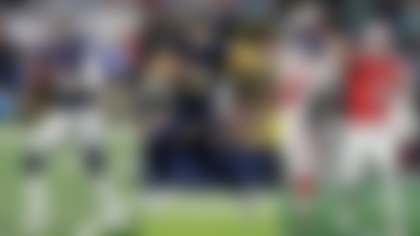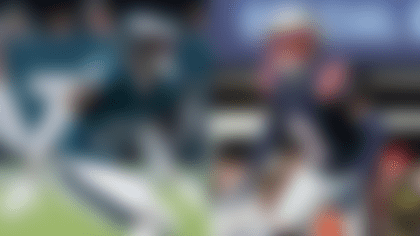Which teams have gotten it right on fourth-down and 2-point conversion calls in Week 15 of the 2021 NFL season so far -- and which teams have gotten it wrong? The Next Gen Stats analytics team uses the Next Gen Stats Decision Guide powered by AWS to break down the numbers behind the decisions that shaped the game.


John Harbaugh goes for 2 and the win (again) and falls short (again)
FOURTH QUARTER: With 42 seconds remaining, the Ravens (trailing 31-30) elect to go for 2 and the lead instead of opting for an extra point and a tie. Tyler Huntley's pass to Mark Andrews falls incomplete.
Two weeks ago, the Ravens failed to successfully convert when trying for a win-clinching 2-point conversion against the division-rival Steelers. But there are two key differences between that situation and this scenario on Sunday against the Packers: the quarterback and the amount of time left in the game. Against the Steelers, there was 11 seconds left and Lamar Jackson was at quarterback; against the Packers, there were 42 seconds remaining, and Huntley, Jackson's backup, was on the field.
The first question we have to answer before making a recommendation: How much does the quarterback affect the team's chances of converting if they go for two? With Jackson at quarterback, in the same situation against the Steelers, we had Baltimore's conversion chances at 48 percent; with Huntley under center against the Packers, that number dropped to 38 percent. Agnostic of Aaron Rodgers' chances of driving down the field in 42 seconds to set up a game-winning field goal (and remember that Rodgers did exactly this in a similar scenario against the Niners in Week 3), the expected points of going for 2 (two multiplied by the probability of converting, which equals 0.76 points) was already less than the expected points of Justin Tucker kicking the PAT (essentially 0.99 points).
The value (in points) of each decision is not enough to formulate an efficient analytics recommendation. Harbaugh and Co. had to consider the likelihood of losing in regulation (even if they successfully converted for 2) or in overtime. Don't forget that the Ravens entered the game as heavy underdogs. As in the situation against the Steelers, the Decision Guide recommended kicking the extra point, but Harbaugh must have calculated that going for 2, as risky as it was, represented his best chance to pull off the upset vs. taking his chances in a possible overtime, even taking into account the difficulty of preventing Rodgers from scoring with that much time remaining.

Decision Guide backs Brandon Staley's approach
On Thursday Night Football, facing a divisional foe in a key prime-time matchup, the Chargers converted just two of their five fourth-down tries in an overtime loss to the Chiefs. No matter -- The NGS Decision Guide matched Staley's decision in all five situations, creating what you could call a case of right process, wrong outcome.
Consider that all five fourth-down calls came with 5 yards or fewer to go, and four of the plays were with 2 yards or fewer to go. As we have seen in this NGS Decision Guide series throughout the season, going for it in short-yardage situations is often the most optimal fourth-down strategy, especially in a game where touchdowns are at a premium (and you're playing against Patrick Mahomes).
Staley has been transparent in his approach all season: He is going to make decisions that put his team in the best position to win games. Staley has made the optimal call on 20 of 28 decisions for a rate of 71 percent; only one coach has a higher optimal fourth-down decision rate when the numbers suggest going for it by more than 1 percentage point (the Browns' Kevin Stefanski, at 83 percent). Though it might be tempting to focus on the Chargers' failed conversion attempts in a loss, Staley's consistency on fourth down gave the team a better chance to emerge victorious.
Frank Reich leans on the QB sneak
If the data is any indication, the Colts' head coach understands the value of inches when it comes to fourth-down decision making. Indianapolis has gone for it 12 times this season when facing less than 1 actual yard to go, as measured by the tracking data. That's five more times than any other team.
In a crucial Week 15 victory over the Patriots, the Colts faced fourth-and-less-than-1 three times (as measured by our ball-tracking technology). The offense converted via QB sneak on all three plays.
Let's take a closer look at one such situation:
FOURTH QUARTER: With 5:38 remaining and the Colts (leading 20-10) facing a fourth-and-1 from their own 43-yard line, Carson Wentz dives forward for 1-yard to convert on the quarterback sneak.
Since 2016, when an offense has the ball within one yard of the sticks, the team has converted for a first down or scored a touchdown on 70 percent of go-for-it attempts. In this specific scenario, the Colts had only 0.8 yards to go (again, per ball-tracking technology). In line with historical trends, we also had the conversion probability here at 70 percent. With such a high conversion probability, the quarterback sneak in inches-to-go situations is an optimal strategy when you have a quarterback like Wentz, who excels in such situations.
Bill Belichick opts for 3 points despite big deficit
FOURTH QUARTER: With 9:00 remaining and the Patriots (trailing 20-7) facing a fourth-and-goal from the Colts' 7-yard line, Nick Folk makes a 25-yard field goal.
Belichick's conservative approach to fourth-down decision-making continued on Saturday night.
The NGS Decision Guide pegged this as a go-for-it situation by 0.8 percentage points in win-probability value, a number deflated by the Patriots' low chances of winning at the time of the decision (6.7 percent before the play). Yes, the odds of converting with 7 yards to go were only at 40 percent, but kicking here still left the Patriots two possessions behind with nine minutes on the clock. New England had to get the ball back twice to at least force overtime, and that was far from guaranteed, given the way Jonathan Taylor and the Colts' running game were clicking.
Belichick has been leaving points on the field as a result of suboptimal fourth-down decisions all season long. The six-time Super Bowl champion's decision rate when the numbers suggest going for it by more than 1 percentage point sits at 25 percent (4 of 16), putting him 31st in the NFL -- only the Seahawks' Pete Carroll is making optimal decisions on fourth down at a lower rate this season (24%).


Dan Campbell stays aggressive in upset win
SECOND QUARTER: With 31 seconds remaining and the Lions (leading 10-0) facing a fourth-and-1 from the Cardinals' 28-yard line, Jared Goff finds Amon-Ra St. Brown for a 6-yard reception, resulting in a first down.
Having entered the game as a sizable underdog, the Lions were looking to build on their surprising lead in the final ticks of the first half. Rather than opting for a field goal and settling for 3 points, Campbell and staff kept the offense on the field to try for 6.
According to our conversion-probability models, the Lions had roughly the same probability of gaining a first down (63%) as they did of making a 46-yard field goal (65%). With more upside in keeping the drive alive, the NGS Decision Guide leaned towards going for it by a difference of 1.8 percentage points in win-probability value. Converting on the play allowed the Lions to take more shots at the end zone, and it paid off on the very next play, as Goff connected with Josh Reynolds on a 22-yard touchdown pass, pushing Detroit's advantage to 17-0.
Entering Monday's slate of Week 15 games, Campbell ranked fifth among NFL head coaches in optimal call percentage in situations where the numbers say go for it by at least 1 percentage point in win-probability value (63%).
Kliff Kingsbury gets conservative facing second-half deficit
On the other sideline, Kingsbury and Arizona became uncharacteristically conservative in the second half while trying to mount a comeback. The Cardinals faced two fourth downs in the third quarter, and in both scenarios, they settled for field goals despite trailing by three possessions. These two choices cost the Cardinals a combined 7.6 percentage points in win-probability value.
THIRD QUARTER: With 11:26 remaining and the Cardinals (trailing 17-0) facing a fourth-and-3 from the Lions' 11-yard line, Matt Prater kicks a 29-yard field goal.
The Cardinals' offense stalled out deep in Lions territory on their first possession coming out of the half. Yes, this field-goal try was a virtual chip-shot (carrying a 93 percent make probability), but scoring 3 points was not going to help Arizona make up very much ground. The Cardinals' Kyler Murray-led offense, on the other hand, had a 56 percent chance of gaining enough yards to secure a first down. By combining the likelihood of each outcome with the impact of each outcome on win probability, the NGS Decision Guide found that going for it was 5.4 percentage points more advantageous than kicking a field goal. The decision to kick instead would go down as the most suboptimal of the week through the Sunday Week 15 slate.
Kingsbury entered the week ranked third in optimal decision rate in situations where the numbers said go for it by at least 1 percentage point (64 percent). Following this loss to the two-win Lions, Kingsbury fell to 10th (56%).
Follow the Next Gen Stats team on Twitter.















